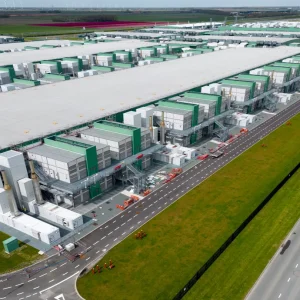
We have heard of data centres excess heat being used to heat up water in swimming pools, such as telco provider Swisscomm’s Wankdorf data centre in Berne.
However, there is a revolution, hailed by some as simply an evolution, in the data centre space, which is taking hubs so close to the water that they have in fact gone under the sea.
CBR lists some of the data centre adventures taking IT to wet and high places.

1. Microsoft
No one has ever got closer to the water like Microsoft has (but also, not everyone has the money Microsoft has to do it). The company has literally taken the data centre game to the extreme by placing a full working hub under water.
Project Natick, as the experiment has been dubbed, placed a prototype self-contained data centre pod, christened the Leona Philpot, 30-feet below the water level, off the coast of San Luis Obispo, California, US.
Microsoft believes that by putting data centres under water, cooling costs would be dramatically reduced and it would also be able to provide services quicker when localised market demand surges, an area is affected by a natural disaster, or when a major event is held in a given place.
Steve Weiner, Sr lead product manager for global collocation services at CenturyLink EMEA, said: "Microsoft is certainly showing innovation and challenging the status quo here, but I would question whether the brand is just fishing for publicity and hefty R&D costs will eventually be passed down to customers or shareholders.
"Practical security and access issues need to be thought about: other than sealing the container, is there no way of accessing the physical servers? – And if there is a hurricane overhead, it may be extremely hard to get down there to resolve any problems."

2. Google
Back in February 2007, Google filled a patent with the United States Patent and Trademark Office (USPTO) which was only made public in April 2009 (above).
The document shows a system that includes a floating platform-mounted computer data centre comprising a plurality of computing units, a sea-based electrical generator in electrical connection with the plurality of computing units, and one or more seawater cooling units for providing cooling to the plurality of computing units.
The company defended the idea saying that the system provides quick and flexible deployments anywhere as the public use of the internet continues to grow, with millions of people now accessing the global network.
It said that the computing units might be mounted in a plurality of crane-removable modules. The sea-powered electrical generator may comprise a wave-powered generator system, and may further include a plurality of motion-powered machines arranged in a grid and wired together. The wave-powered electrical generator system may likewise comprise one or more Pelamis machines.
The drafts filled by Google show that an heliport would be placed at the front of the barge, suggesting that engineers would be flown in and out of the sea vehicle by helicopter.

3. Nautilus Data Technologies
While Google has never really taken its idea out of the paper (as far as we know), data centre services provider Nautilus Data Technologies has initiated the construction of a waterborne data centre last November.
The world’s first floating data centre (above) is set to be launched this year, and follows a successful trial of a PoC which proved a cooling cost reduction of 30% by using natural sources such as wind and water to cool down servers.
The waterborne will offer business continuity, disaster recovery services and help with primary computing needs by offering hosting, collocation and cloud services.
Arnold Magcale, CEO of Nautilus Data Technologies, told Reuters: "The Nautilus proof of concept prototype exceeded all expectations — validating how our waterborne approach will provide the most cost effective, energy efficient and environmentally sustainable data centre on the market.
"Our innovations are the most significant data centre advances in decades — marking a revolutionary change in the data centre industry."

4. Sealand
Off the coast of Suffolk, England, there is a principality called Sealand. The former 120-by-50-foot anti-aircraft deck built by the British government to protect the UK from Nazi attacks during the WWII, has been converted in 2000 by HavenCo to operate as a data centre in the North Sea.
Shut down in 2008, the site was the first data heaven in the world allowing users and companies to storage data they wanted to hide from the authorities. Even Pirate Bay showed interest in buying the infrastructure before this one closed down.
In 2013, HavenCo re-launched with the help internet entrepreneur Avi Freedman, bringing back the micronation’s IT game.
This time, the company is offering proxies, VPNs and other services using servers in the European Union and the United States and while storing encryption keys and other cold data in Sealand.
In 2008, Sealand was estimated to be worth £576 million. In an interview to the BBC in November 2015, the principality’s communications director for the Seasteading Institute said that they are planning expanding their territory with seasteading infrastructures, aka floating platforms on where cities can be built.
5. If H2O doesn’t surprise you, there’s always space
While Microsoft’s push for underwater data centres has sparked a series of reactions from industry experts, in 2013, Emerson Network Power‘s VP of business development and energy initiates, Jack Pouchet, launched the idea of deploying data centres in space.
He said that it is possible to put something in space for $100 million, a value not too high when we look at collocation providers like Switch SUPERNAP who are investing $5 billion in a single data centre, or Apple who is investing nearly $1 billion in an Irish data centre.
Pouchet told Co.Exist: "If you look at underserved markets, the population growth in Southeast Asia and Africa, and the cost of building a physical data centre — bringing in roads, power, people, and broadband connectivity could be in the half a billion dollar range. You could put something in space for $100 million."
He suggested that hubs could be placed in a geosynchronous orbit (GSO), an orbit around the Earth with an orbital period of one sidereal day, intentionally matching the Earth’s sidereal rotation period (approximately 23 hours 56 minutes and 4 seconds), according to Orbital Mechanics’s author V. Chobotov.
Latency would not be as latency is on Earth; however Pouchet said that the hub could be used for "cold storage", such as old Tweets. To power the infrastructure, operators could use the same technology currently used on satellites such as space-based solar panels.
Pouchet said: "It could be up to a year before people can go to do an upgrade and make replacements."







